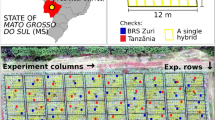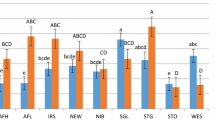Abstract
The effect of interplant distance on differentiation and selection a) of the superior lines from a mixture of inbred lines, and b) of individual plants originating from the top lines, was studied in chickpeas (Cicer arietinum L.). For this, 28 chickpea inbred lines were evaluated on a single plant basis in a honeycomb design and in the same field at three interplant distances, for four growing seasons, at Larissa, Greece. The interplant distances were 15 cm (520000plants/ha, strong allo-competition), 30 cm(128630 plants/ha, medium allo-competition) and 100 cm (11500plants/ha, without competition). In addition, the inbred lines were evaluated in replicated plot trials under an agronomically accepted plant stand (520000plants/ha, crop environment) and the ranking of the 28 lines based on the average yield per plot over growing seasons was determined. Selection was applied in each season for each interplant distance and the three and six top lines with the highest average yield per plant were identified. These top lines from each interplant distance were compared with the three and six top lines(say: proven superior lines) identified after their evaluation under crop environment over seasons. In addition, selection was applied at the individual plant level with six selection pressures in each season and each interplant distance. Then we determined for each experiment and selection pressure the number of the selected plants which belonged to the six proven top lines. It was observed that the ranking obtained under crop environment was best correlated with the ranking at the intermediate interplant distance (30 cm), followed by the ranking at the high interplant distance (100 cm). In contrast this correlation was very weak for the ranking at low interplant distance (15 cm).In addition, the interplant distance identifying the highest number of the proven high yielding lines after their evaluation in one season was the intermediate interplant distance followed by the high interplant distance and certainly not the low interplant distance. The relative effectiveness was further increased when selection was based on average performance of the lines across seasons. This, together with the relatively small number of seeds produced per plant, renders selection at low interplant distance less favorable than selection at the intermediate or high interplant distance.The individual plant selection was effective at all three interplant distances. Selection effectiveness generally increased as the selection pressure increased. Again the best results were obtained when selection was applied at intermediate or at high interplant distance. It was concluded that line selection as well as individual plant selection was more effective at intermediate interplant distance and certainly not at low interplant distance.
Similar content being viewed by others
References
Atkins, R.E., 1964. Visual selection for grain yield in barley. Crop Sci 4: 494-497.
Batzios, D.P. & D.G. Roupakias, 1997. A microcomputer program for plant selection and analyses of the honeycomb designs. Crop Sci 37: 744-747.
Batzios, D.P., D.G. Roupakias, U. Kechagia & S. Galanopoulou-Sendouca, 2001. Comparative efficiency of honeycomb and conventional pedigree methods of selection for yield and fiber quality in cotton (Gossypium spp.). Euphytica 122: 203-211.
Bussemakers, A. & I. Bos, 1999. The effect of interplant distance on the effectiveness of honeycomb selection in spring rye. III Accumulated results of five selection cycles. Euphytica 105: 229-237.
Calcagno, F., G. Gallo, J. Raimondo, G. Venora & M. Jatani, 1987. Early planting to increase and stabilize the chickpea crop in hot dry environments. ENED La Coltura Del Cece in Italia: 130-131.
De Pauw, R.M. & L.H. Shebeski, 1973. An evaluation of an early generation yield testing procedure in Triticum aestivum L. Can J Plant Sci 53: 465-470.
Falconer, D.S., 1989. Introduction to Quantitative Genetics. 3rd edn. Longman Scientific and Technical, Hong Kong.
Fasoulas, A.C., 1981. Principles and Methods of Plant Breeding. Dept. Gen. Plant Breeding. Aristotelian Univ. of Thessaloniki, Greece Publ. 11, 147 pp.
Fasoulas, A.C., 1993. Principles of Crop Breeding. Dept. Gen. Plant Breeding. Aristotelian Univ. of Thessaloniki, Greece, 127 pp.
Fasoulas, A.C. & V.A. Fasoula, 1995. Honeycomb selection designs. Plant Breed Rev 13: 87-139.
Fasoula, D.A. & V.A. Fasoula, 1997. Competitive ability and plant breeding. Plant Breed Rev 14: 89-138.
Gardner, C.O., 1961. An evaluation of effects of mass selection and seed irradiation with thermal neutrons on yield of corn. Crop Sci 1: 241-245.
Gill, J.S., M.M. Verma, R.K. Gumber & J.S. Brar, 1995. Comparative efficiency of four selection methods for deriving highyielding lines in mungbean (Vigna radiata L.). Theor Appl Genet 90: 554-560.
Hanson, P.R., G. Jenkins & B. Westcott, 1979. Early generation selection in a cross of spring barley. Z Pflanzenzüchtg 83: 64-80.
Hinson, K. & W.D. Hanson, 1962. Competition studies in soybeans. Crop Sci 2: 117-123.
Iliadis, C., 1998. Chickpea seed yield increase by autumn sowing. In: Proc. 3rd European Conf. Grain Legumes, 14-19 November 1998, Valladolid, Spain, pp. 149.
Kyriakou, D.T. & A.C. Fasoulas, 1985. Effects of competition and selection pressure on yield response in winter rye (Secale cereale L.). Euphytica 34: 883-895.
Lungu, D.M., P.J. Kaltsikes & E.N. Larter, 1987. Honeycomb selection for yield in early generations of spring wheat. Euphytica 36: 831-839.
McKenzie, R.I.H. & J.W. Lambert, 1961. A comparison of F3 lines and their related F6 lines in two barley crosses. Crop Sci 1: 246-249.
Mitchell, J.W., R.J. Baker & D.R. Knott, 1982. Evaluation of honeycomb selection for single plant yield in durum wheat. Crop Sci 22: 840-843.
Ntanos, D. & D. Roupakias, 2001. Comparative efficiency of two breeding methods for yield and quality in rice. Crop Sci 41: 345-350.
Poehlman, J.M. & D.A. Sleper, 1995. Breeding Field Crops. Iowa State University Press (4th edn.), pp. 164-166.
Robertson, L.D. & K.J. Frey, 1987. Honeycomb design for selection among homozygous oat lines. Crop Sci 27: 1105-1108.
Roupakias, D., A. Zesopoulou, S. Kazolea, G. Dalkalitses, A. Mavromatis & T. Lazaridou, 1997. Effectiveness of early generation selection under two plant densities in faba bean (Vicia faba L.). Euphytica 93: 63-70.
Sakai, K.I., 1961. Competitive ability in plants: its inheritance and related problems. In: F.L. Milthorpe (Ed.), Mechanisms in Biological Competition, pp. 245-263. Symp. Soc. Exp. Biol. No 15, Cambridge Univ. Press.
Sarno, R., L. Stringi, G. Amato & M. Crivello, 1987. Effects of sowing time on yield and its components in some chickpea genotypes. ENED La Coltura Del Cece in Italia: 132-139.
Shebeski, L.H., 1967. Wheat and breeding. In: K.F. Nielson (Ed.), Proc. Can. Centennial Wheat Symp. Saskatoon, Saskatchewan, pp. 249-272.
Singh, K.B., 1987. Chickpea breeding. In: M.C. Saxena & K.B. Singh (Eds.), The chickpea, pp. 127. C.A.B. The Cambrian News Ltd., Aberystwyth, 409 pp.
Sneep, J., 1977. Selection for yield in early generations of selffertilizing crops. Euphytica 26: 27-30.
Stratilakis, S.N. & C.K. Goulas, 2002. Yield performance at three nitrogen rates of a set of honeycomb vs traditional pedigree selected bread wheat varieties. European Journal of Agronomy (in press).
Stuthman, D.D. & R.P. Steidl, 1976. Observed gain from visual selection for yield in diverse oat populations. Crop Sci 16: 262-264.
Syme, J.R., 1972. Single-plant characters as a measure of field plot performance of wheat cultivars. Aust J Agric Res 23: 753-760.
Townley-Smith, T.F. & E.A. Hurd, 1973. Use of moving means in wheat yield trials. Can J Plant Sci 53: 447-450.
Traka-Mavrona, E., D. Georgakis, M. Koutsika-Sotiriou & T. Pritsa, 2000. An integrated approach of breeding and maintaining an elite cultivar of snap bean. Agron J 92: 1020-1026.
Author information
Authors and Affiliations
Rights and permissions
About this article
Cite this article
Iliadis, G., Roupakias, D. & Goulas, C. Effectiveness of honeycomb selection for yield superiority at three interplant distances: a field simulation study using chickpea (Cicer arietinum L.) inbred lines. Euphytica 133, 299–311 (2003). https://doi.org/10.1023/A:1025757817020
Issue Date:
DOI: https://doi.org/10.1023/A:1025757817020




